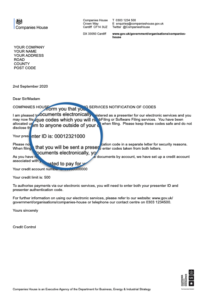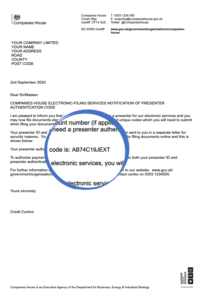Documents filed electronically at Companies House must include details of who is ‘presenting’ the document. This lets Companies House know who to contact about a transaction, and can also provide a more efficient billing arrangement for chargeable submissions.
This can all be achieved by obtaining a presenter code from Companies House.
Generally, for those managing more than a few companies – and particularly for firms of accountants – it is attractive to have your own Companies House presenter code. Increases to Companies House fees take effect from 1 May 2024, with every electronic confirmation statement costing £34 and a new company formation charged at £50. Especially with these higher fees, accountants and other volume filers of chargeable documents will benefit from a presenter code which includes a credit facility. That enables fees to be paid monthly in arrears in one payment via a credit account, rather than making the payment at the time each submission is made.
A better way to manage company secretarial work
Inform Direct is the perfect tool to help make company secretarial work a whole lot easier:
> Manage details of officers, PSCs and shares
> Automatic updates to statutory registers
> Easy filing of forms with Companies House
> Create documents from 400+ templates
> Backed by dedicated, passionate support
A presenter code is unique to a particular firm, but you can use the same presenter code to make filings for multiple companies. Some firms choose to have multiple presenter codes – for example, one code per office in an accountancy practice – but this is unusual.
What does the presenter code look like?
A presenter code is allocated by Companies House. It consists of two separate elements:
- A presenter identifier (or ‘presenter id’) – always 11 digits, for example 00220022002
- A presenter authentication code – also 11 characters long, a mix of upper case letters and numbers, for example AC75D45JUQA
You will need both to file, with the presenter authentication code acting like a password.
Note that your Companies House presenter code is different to:
- The email address and password (formerly called a ‘security code’) that you may use to log into WebFiling
- The company registration number of the company you’re filing for
- The company authentication code, which you will also need to file for a company
- The registered email address of the company you’re filing for
Types of presenter code
There are two main types of Companies House presenter code:
- A presenter code without a credit facility – this allows submissions to be made for multiple companies in the name of the presenter, but chargeable transactions – any that require the payment of a fee to Companies House – will still need you to pay the applicable amount each time you make a submission.
- A presenter code with a credit facility – as well as submissions appearing in the name of the presenter, this allows chargeable transactions such as company formations and confirmation statements to be made without needing to pay each time you make a submission. Instead, you receive a monthly statement direct from Companies House detailing all the transactions which incurred one of their filing fees in the previous month and pay a single combined monthly amount.
To achieve the full benefit, most accountants obtain a presenter code with a credit facility. It’s this type of presenter code that can be added to your Inform Direct account.
Without a presenter code, an accountant will need to pay each time a chargeable transaction is made. As they’re not recorded as the presenter of the submission, it’s also possible that any related queries will go elsewhere, possibly to the underlying company.
What are the advantages of having a Companies House presenter code?
There are many advantages for accountants and other bulk filers to obtain their own presenter code (particularly one with a credit facility) to make Companies House submissions:
1 Reduced administration and easier reconciliation
For many accountants and other businesses, it will just not be convenient to make payments by card whenever a chargeable submission is made. The business’s credit card may not be easily accessible to those making filings. Even for those with credit card access, entering the details for each payment feels unnecessary and laborious. You’ll need to maintain records of payments made, linking those to the relevant company.
With a presenter code, your business will pay a single combined payment to Companies House in arrears. Companies House also provide handy statements allowing for easier reconciliation, with details of which company payments relate to, the amount and the paid transaction type (company formation, confirmation statement, change of company name etc.).
2 Remove strain on your credit card and risk of interruptions
If you settle fees individually by credit or debit card, it can entail a high number of repetitive payments of the same amount to the same merchant on the same day. For example, if you have lots of confirmation statements to file, your card will be charged (from 1 May 2024) £34 for each submission.
Occasionally, a bank might challenge or even reject such repetitive payments, potentially blocking the card. Making individual payments can also be problematic if the credit card is lost or stolen, or if Companies House’s payment facility is temporarily unavailable.
These issues are entirely avoided if you put in place a presenter code with credit facility.
3 An agent is treated as the presenter of filings made for clients
For an accountant, solicitor or other company secretarial agent, it is often important – and expected by clients – to be shown as the presenter of submissions. That is only assured if your firm makes filings under its own presenter code.
Companies House will usually approach the presenter of information with any queries about a submission. Given the early signs that Companies House intends actively to use its new powers increasingly to query and challenge information, accountants will want to act as the presenter to ensure they receive those queries first. Putting a presenter code in place can help an accountant to maintain control over the status of submissions.
4 Companies House provide up to 60 days credit
Companies House only takes payment for chargeable filings 30 days after a month end. Therefore, the £34 fee for a confirmation statement made on 1 July 2024 would only require settlement at the end of August. This can assist with cashflow, particularly where your business relies on a client reimbursing you for the cost of chargeable submissions.
This will be a particularly important consideration for accountants as they work with clients to adjust to Companies House’s uprated fees with effect from 1 May 2024.
5 Full access to Inform Direct functionality
While some Inform Direct users utilise the software without one, there are some features that we can only make available if you use your own Companies House presenter code. These valuable extra features include:
- Enabling the facility to file confirmation statements automatically on a pre-defined date, without you needing to click a button
- Uploading and submitting iXBRL accounts to Companies House
- Registering a new mortgage or an existing charge newly acquired with Companies House
- Informing Companies House of updates, including full or partial satisfaction, and full or partial release of a mortgage or charge.
How to get your own presenter code
It is really straightforward to obtain a Companies House presenter code:
- Download the appropriate form
- Return the completed form to [email protected]
- Wait up to five working days for Companies House to process your application
- Companies House will allocate a presenter identifier and presenter authentication code
For security reasons, the presenter identifier and presenter authentication code will be sent in separate letters to your chosen contact address. You’ll need both before you can use the account to make submissions.
If you already subscribe to Inform Direct to manage your company secretarial work, you can add your presenter code with a credit facility. By doing so, you’ll no longer need to pay Inform Direct for chargeable transactions you make in the software.
Managing your Companies House presenter code
A presenter code can make life much easier for those making regular submissions to Companies House. Here’s a few things to consider to help you make the most of your presenter code:
- Make sure your credit account remains topped up with sufficient funds, to avoid the possibility that submissions attracting a Companies House fee will fail.
- Speak to Companies House to negotiate an increase in your credit facility as your business – and volume of chargeable transactions – expands. Usually, you will be able to arrange an updated facility based on your history of payments to date.
- Accountants with an existing credit account ahead of the fee increases on 1 May 2024 will want to check with Companies House that their credit limit is increased to accommodate the higher level of future fees.
- Keep your presenter identifier and presenter authentication code private, just as you would the authentication code for a single company. If you fear that someone has discovered or used your presenter details without your knowledge, you can request a replacement from Companies House.
Inform Direct makes it quick and easy to maintain statutory registers, manage company records and submit filings to Companies House at the touch of a button.


